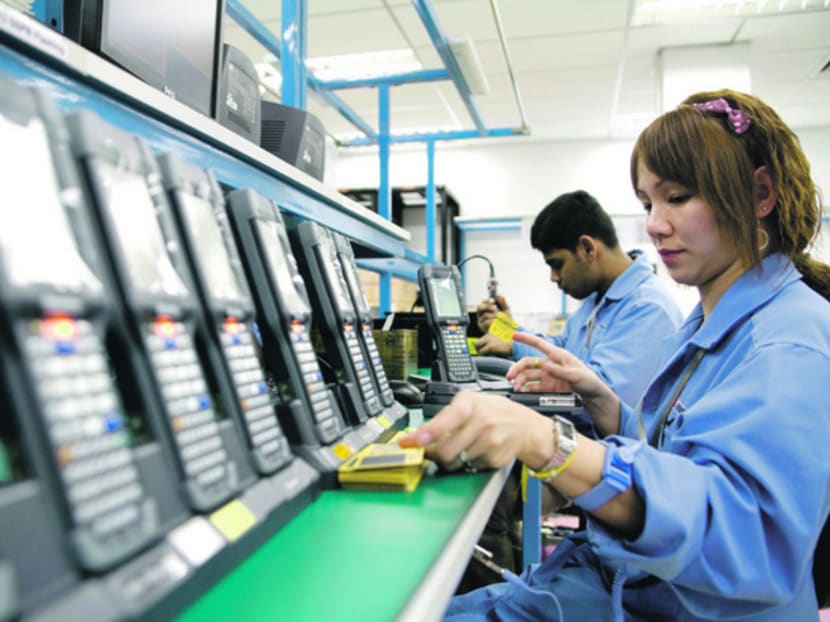Weaker than expected bump in factory output
SINGAPORE — The Republic’s manufacturing sector staged a modest rebound last month thanks to strong biomedical output, but the results were far lower than the 3.7 per cent rise economists had predicted in a Reuters poll.

Workers test hand-held inventory computer devices on an assembly line at a factory in Singapore. Photo: Bloomberg
SINGAPORE — The Republic’s manufacturing sector staged a modest rebound last month thanks to strong biomedical output, but the results were far lower than the 3.7 per cent rise economists had predicted in a Reuters poll.
Economists said the weaker-than-expected footing, coming on the back of an anaemic last quarter, will probably weigh on Singapore’s gross domestic product growth prospects in the first quarter.
Factory output edged up 0.9 per cent in January compared with the corresponding period last year, reversing from a 1.9 per cent fall in December, the Economic Development Board said yesterday. Excluding the volatile biomedical manufacturing, output was unchanged for the month.
“Output was expected to be higher because of the low base effect from a year ago, when Lunar New Year was in January, as businesses will usually stock up a month before the festive period,” said Mr Michael Wan, an economist at Credit Suisse.
January’s mild increase was boosted mainly by higher output in the biomedical cluster, which rose 5.3 per cent to reverse a 1.2 per cent decline the previous month, on robust demand for new medical devices. The precision engineering cluster too posted a gain at 4.1 per cent, albeit slowing from an increase of 8.9 per cent in December.
However, being the only two clusters to experience positive on-year growth, their gains were not enough to drive greater growth.
“With only a 30 per cent share of total manufacturing output, it was not enough to push industrial production growth towards the market expected growth rate,” said UOB economists Francis Tan and Jimmy Koh in a research note.
The key electronics cluster, which makes up a third of industrial production, was unchanged last month, in spite of growth in the other electronic modules and components segment, as well as the semiconductors and computer peripherals segments.
The other clusters — general manufacturing industries, chemicals and transport engineering — fell by 0.3 per cent, 0.5 per cent and 2.2 per cent, respectively.
“I think we were all hoping for a stronger lift from the electronics sector. Also the volatile performance of the biomedical cluster makes the manufacturing output figures difficult to predict,” said Mr Song Seng Wun, regional economist for CIMB Research.
Before the expansion last month, manufacturing output had contracted for three out of four months between September to December as faltering global demand and low oil prices took their toll. Economists have expressed concerns that the same challenges from the earlier months will probably creep up again in the coming months.
“With January’s industrial production starting off on a weaker-than-expected footing, it adds on to concerns on several headwinds facing the manufacturing sector in the coming months,” said Mr Tan and Mr Koh, citing weak economic conditions in both the eurozone and Japan, persistent low global oil prices and tight labour conditions on the home front.
However, not all is lost as a stronger American economic recovery this year will improve demand for semiconductors and benefit the electronics manufacturing cluster, the UOB economists added.
That said, some economists also said they expect the manufacturing sector to continue to drag down Singapore’s economic growth prospects. “First-quarter gross domestic product growth is likely to be weak because of January’s (figures); GDP is likely to contract on a quarter-on-quarter basis,” said Mr Wan.
The Republic’s economy expanded at a slower pace of 2.1 per cent in the fourth quarter from a year ago, after growing 2.8 per cent in the previous three months, hurt by a slowdown in manufacturing.





